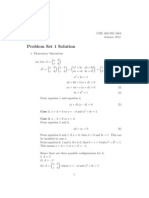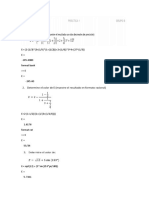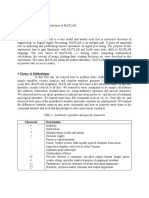Introduc) On To MATLAB For Control Engineers: EE 447 Autumn 2008 Eric Klavins
Uploaded by
Christina HillIntroduc) On To MATLAB For Control Engineers: EE 447 Autumn 2008 Eric Klavins
Uploaded by
Christina HilllnLroducuon Lo MA1LA8
for ConLrol Lnglneers
LL 447
AuLumn 2008
Lrlc klavlns
arL l
MaLrlces and vecLors
>> A=[1 2 3; 4 5 6; 7 8 9]; # A 3x3 matrix
>> x=[1;2;3]; # A n-dim (column) vector
WhlLespace separaLes enLrles and a semlcolon separaLes rows.
>> A(2,3)
ans =
6
>> A(:,2)
ans =
2
5
8
>> A(3,3)=-1
ans =
1 2 3
4 5 6
7 8 -1
?ou can access parLs
>> A # transpose
>> A*x # multiplication
>> A*A
>> x*x
>> det(A) # determinant
>> inv(A)
...
All Lhe sLandard sLu ls Lhere
Llgenvalues and LlgenvecLors
>> [P,D] = eigs(A)
P =
-0.3054 -0.2580 -0.7530
-0.7238 -0.3770 0.6525
-0.6187 0.8896 -0.0847
D =
11.8161 0 0
0 -6.4206 0
0 0 -0.3954
>> P*D*inv(P)
ans =
1.0000 2.0000 3.0000
4.0000 5.0000 6.0000
7.0000 8.0000 -1.0000
>> A
A =
1 2 3
4 5 6
7 8 -1
!ordan lorm
>> B=[1 3 4 1; 0 1 1 2; 0 0 1 0; 0 0 0 1]
B =
1 3 4 1
0 1 1 2
0 0 1 0
0 0 0 1
>> [M,J]=jordan(B)
M =
3.0000 0 0 0
0 1.0000 1.0000 2.3333
0 0 -1.0000 -2.0000
0 0 1.0000 1.0000
J =
1 1 0 0
0 1 1 0
0 0 1 0
0 0 0 1
>> M*J*inv(M)
ans =
1.0000 3.0000 4.0000 1.0000
0 1.0000 1.0000 2.0000
0 0 1.0000 0
0 0 0 1.0000
Solvlng Ax=b for x
>> A
A =
1 3 4 1
0 1 1 2
0 0 1 0
0 0 0 1
>> b=[1;0;1;0]
b =
1
0
1
0
>> x=A\b
x =
0
-1
1
0
Symbollc Calculauons
>> syms k # declares k to be a symbol
>> A=[1 k; k 1]
A =
[ 1, k]
[ k, 1]
>> [M,J]=jordan(A)
M =
[ 1/2, 1/2]
[ -1/2, 1/2]
J =
[ -k+1, 0]
[ 0, k+1]
>> syms lam
>> cp=det(lam * eye(2) - A)
cp =
lam^2-2*lam+1-k^2
>> lam=solve(cp)
lam =
k+1
-k+1
1he 2x2 ldenuLy
maLrlx
Solvlng ulerenual Lquauons LxacLly
>> sol=dsolve('Dx = a*x + b', 'x(0) = x0')
sol =
-1/a*b+exp(a*t)*(x0+1/a*b)
>> f=subs ( sol, {'a','b','x0'}, {-1,2,3} )
f =
2+exp(-t)
>> tp=0:0.1:10;
>> plot(tp,subs(f,tp))
Solvlng ulerenual Lquauons
ApproxlmaLely
# this defines a function of t and a column vector x
>> f = @(t,x) [ -x(1) - x(2)^2; sin(x(1)) ]
>> f(1,[2,3]) # for example, this is f
# applied to some arguments
ans =
-11.0000
0.9093
>> [t,x] = ode45 ( f, [0,20], [1,1] );
# the ode45 function numerically
# simulates the ode represented by f
>> plot ( t, x(:,1), t, x(:,2) )
>> legend('x1(t)', 'x2(t)')
ume lnLerval
lnlual condluon
Solvlng ulerenual Lquauons
ApproxlmaLely
# this defines a function of t and a column vector x
>> f = @(t,x) [ -x(1) - x(2)^2; sin(x(1)) ]
>> f(1,[2,3]) # for example, this is f
# applied to some arguments
ans =
-11.0000
0.9093
>> [t,x] = ode45 ( f, [0,20], [1,1] );
# the ode45 function numerically
# simulates the ode represented by f
>> plot ( t, x(:,1), t, x(:,2) )
>> legend('x1(t)', 'x2(t)')
ume lnLerval
lnlual condluon
?ou can also look aL Lhe x-y plane
f = @(t,x) [ -x(1) - x(2)^2; sin(x(1)) ];
hold all
[t,x] = ode45 ( f, [0,20], [2,1] ); plot ( x(:,1), x(:,2) );
[t,x] = ode45 ( f, [0,20], [1,3] ); plot ( x(:,1), x(:,2) );
[t,x] = ode45 ( f, [0,20], [-8,0] ); plot ( x(:,1), x(:,2) );
[X,Y] = meshgrid(-10:1:3,-2:1:3);
DX=-X-Y.^2;
DY=sin(X);
quiver(X,Y,DX,DY);
Pow does numerlcal slmulauon work?
x = f(x, t)
x = lim
h0
x(t + h) x(t)
h
x(t + h) x(t)
h
f(x, t)
x(t + h) x(t) + hf(x, t)
u = u
+
+ u
e = e
+
+ e
y = y
+
+ y
e
+
+ e
y
+
= u
+
y
+
y
= u
y
+
y
y = y
+
y
= (u
+
u
)
= u
k
s +
k
1
x = f(x, t)
x = lim
h0
x(t + h) x(t)
h
x(t + h) x(t)
h
f(x, t)
x(t + h) x(t) + hf(x, t)
u = u
+
+ u
e = e
+
+ e
y = y
+
+ y
e
+
+ e
y
+
= u
+
y
+
y
= u
y
+
y
y = y
+
y
= (u
+
u
)
= u
k
s +
k
1
x = f(x, t)
x = lim
h0
x(t + h) x(t)
h
x(t + h) x(t)
h
f(x, t)
x(t + h) x(t) + hf(x, t)
u = u
+
+ u
e = e
+
+ e
y = y
+
+ y
e
+
+ e
y
+
= u
+
y
+
y
= u
y
+
y
y = y
+
y
= (u
+
u
)
= u
k
s +
k
1
x = f(x, t)
x = lim
h0
x(t + h) x(t)
h
x(t + h) x(t)
h
f(x, t)
x(t + h) x(t) + hf(x, t)
u = u
+
+ u
e = e
+
+ e
y = y
+
+ y
e
+
+ e
y
+
= u
+
y
+
y
= u
y
+
y
y = y
+
y
= (u
+
u
)
= u
k
s +
k
1
f = @(t,x) [ -x(1) - x(2)^2; sin(x(1)) ];
tf=30;
zinit=[1;2];
figure
hold all
for h=0.51:-0.1:0.01
n=int16(tf/h);
t=zeros(1,n);
z=zeros(2,n);
z(:,1) = zinit;
t(1) = 0;
for i=2:n
z(:,i) = z(:,i-1) + h * f ( i*h, z(:,i-1) );
t(i) = i*h;
end
plot ( z(1,:), z(2,:) );
end
luncuons Can be uened ln
llles lnsLead (musL be ln same dlrecLory)
function dx = lorenz_func ( t, x )
sigma = 10;
rho = 28;
beta = 8/3;
dx = [
sigma * ( x(2) - x(1) );
x(1)*(rho-x(3))-x(2);
x(1) * x(2) - beta*x(3)
];
ConLenLs of lorenz_func.m
>> [t,x] = ode45 ( 'lorenz_func', [0,20], [-10,20,-5] );
>> plot3 ( x(:,1), x(:,2), x(:,3) )
>> xlabel('x')
>> ylabel('y')
>> zlabel('z')
luncuons Can be uened ln
llles lnsLead (musL be ln same dlrecLory)
function dx = lorenz_func ( t, x )
sigma = 10;
rho = 28;
beta = 8/3;
dx = [
sigma * ( x(2) - x(1) );
x(1)*(rho-x(3))-x(2);
x(1) * x(2) - beta*x(3)
];
ConLenLs of lorenz_func.m
>> [t,x] = ode45 ( 'lorenz_func', [0,20], [-10,20,-5] );
>> plot3 ( x(:,1), x(:,2), x(:,3) )
>> xlabel('x')
>> ylabel('y')
>> zlabel('z')
Pow Lo use MA1LA8 ln 1hls Class
unless an exerclses says Lo use MA1LA8, you
should do Lhe exerclse by hand.
?ou can use MA1LA8 Lo check your work.
?ou musL show your work ln maLhemaucal
problems and calculauons.
L.g. when ndlng [ordan form, whaL equauons dld
you seL up and solve?
arL ll: An Lxample
mgh
u
a sin b + u
a sin b
0
0
= 0
= 0, , 2, ...
x = f(x, t)
x = lim
h0
x(t + h) x(t)
h
x(t + h) x(t)
h
f(x, t)
x(t + h) x(t) + hf(x, t)
u = u
+
+ u
e = e
+
+ e
y = y
+
+ y
e
+
+ e
1
1he endulum
mgh
u
x = f(x, t)
x = lim
h0
x(t + h) x(t)
h
x(t + h) x(t)
h
f(x, t)
x(t + h) x(t) + hf(x, t)
u = u
+
+ u
e = e
+
+ e
y = y
+
+ y
e
+
+ e
y
+
= u
+
y
+
y
= u
y
+
y
y = y
+
y
= (u
+
u
)
= u
1
mgh
u
x = f(x, t)
x = lim
h0
x(t + h) x(t)
h
x(t + h) x(t)
h
f(x, t)
x(t + h) x(t) + hf(x, t)
u = u
+
+ u
e = e
+
+ e
y = y
+
+ y
e
+
+ e
y
+
= u
+
y
+
y
= u
y
+
y
y = y
+
y
= (u
+
u
)
= u
1
mgh
u
x = f(x, t)
x = lim
h0
x(t + h) x(t)
h
x(t + h) x(t)
h
f(x, t)
x(t + h) x(t) + hf(x, t)
u = u
+
+ u
e = e
+
+ e
y = y
+
+ y
e
+
+ e
y
+
= u
+
y
+
y
= u
y
+
y
y = y
+
y
= (u
+
u
)
= u
1
1orque due Lo gravlLy
1orque due
Lo frlcuon
1orque from moLor
1o do:
1) undersLand Lhe naLural behavlor (when u=0)
2) 8ulld and analyze a feedforward conLroller
3) 8ulld and analyze a proporuonal conLroller
4) 8ulld a u conLroller
3) 8ulld and analyze a lu conLroller
naLural 8ehavlor (u=0)
Lqulllbrlum polnLs
We expecL LhaL 2nn are sLable and (2n+1)n are unsLable - buL we
don'L have Lhe analyucal Lools yeL.
So leL's ploL Lhe vecLor eld.
mgh
u
a sin b + u
a sin b
0
0
= 0
= 0, , 2, ...
x = f(x, t)
x = lim
h0
x(t + h) x(t)
h
x(t + h) x(t)
h
f(x, t)
x(t + h) x(t) + hf(x, t)
u = u
+
+ u
e = e
+
+ e
y = y
+
+ y
e
+
+ e
1
a=1;
b=0.25;
f = @(t,x) [ x(2); -a*sin(x(1)) - b*x(2) ];
hold all
[t,x] = ode45 ( f, [0,20], [pi-0.01,-0.1] );
plot ( x(:,1), x(:,2) );
...
[TH,OM] = meshgrid(-10:1:10,-3:1:3);
DTH=OM;
DOM=-a*sin(TH)-b*OM;
quiver(TH,OM,DTH,DOM);
u
0
sLable unsLable
leedforward
Say we wanL 0 Lo go Lo a deslred angel r.
noLe, sln 0 = 0 so aL equlllbrlum we geL
mgh
u
a sin b + u
a sin b
0
0
= 0
a sin b u a b u u = a + b
u = ar
= 0, , 2, ...
x = f(x, t)
x = lim
h0
x(t + h) x(t)
h
x(t + h) x(t)
h
f(x, t)
x(t + h) x(t) + hf(x, t)
u = u
+
+ u
e = e
+
+ e
mgh
u
a sin b + u
a sin b
0
0
= 0
a sin b u a b u u = a + b
u = ar
= 0, , 2, ...
x = f(x, t)
x = lim
h0
x(t + h) x(t)
h
x(t + h) x(t)
h
f(x, t)
x(t + h) x(t) + hf(x, t)
u = u
+
+ u
e = e
+
+ e
1
Slnce we wanL 0 = r and u = 0 aL equlllbrlum we geL
mgh
u
a sin b + u
a sin b
0
0
= 0
a sin b u a b u u = a + b
u = ar
= 0, , 2, ...
x = f(x, t)
x = lim
h0
x(t + h) x(t)
h
x(t + h) x(t)
h
f(x, t)
x(t + h) x(t) + hf(x, t)
u = u
+
+ u
e = e
+
+ e
1
leedforward
r=0.5;
aguess = 0.95;
uff = aguess * r;
f = @(t,x) [ x(2); -a*sin(x(1)) - b*x(2)
+ uff ];
[t,x] = ode45 ( f, [0,tf], [0,0] );
plot ( t, x(:,1), [0 tf], [r r] );
aguess=0.5;
uff = aguess * r;
f = @(t,x) [ x(2); -a*sin(x(1)) - b*x(2)
+ uff ];
[t,x] = ode45 ( f, [0,tf], [0,0] );
plot ( t, x(:,1), [0 tf], [r r] );
roporuonal leedback
mgh
u
a sin b + u
a sin b
0
0
= 0
a sin b u a b u u = a + b
u = ar
= 0, , 2, ...
x = f(x, t)
e = r
u = u
ff
+ u
fb
= ar + K
p
e
x = lim
h0
x(t + h) x(t)
h
x(t + h) x(t)
h
f(x, t)
x(t + h) x(t) + hf(x, t)
1
Can make Lhe sLeady
sLaLe error small by
Lurnlng up kp.
1hls rlng" ls
annoylng.
roporuonal-uerlvauve ConLrol
mgh
u
a sin b + u
a sin b
0
0
= 0
a sin b u a b u u = a + b
u = ar
= 0, , 2, ...
x = f(x, t)
e = r
u = u
ff
+ u
fb
= ar + K
p
e
u = u
ff
+ u
fb
= ar + K
p
e + K
d
e
e =
x = lim
h0
x(t + h) x(t)
h
1
lnLegral leedback
uene a new sLaLe z (malnLalned by Lhe conLroller) and puL
mgh
u
a sin b + u
a sin b
0
0
= 0
a sin b u a b u u = a + b
u = ar
= 0, , 2, ...
x = f(x, t)
e = r
u = u
ff
+ u
fb
= ar + K
p
e
u = u
ff
+ u
fb
= ar + K
p
e + K
d
e
e =
z = e
1
u = u
ff
+ u
fb
= ar + K
p
e + K
d
e + K
I
z
x = lim
h0
x(t + h) x(t)
h
x(t + h) x(t)
h
f(x, t)
x(t + h) x(t) + hf(x, t)
u = u
+
+ u
e = e
+
+ e
y = y
+
+ y
e
+
+ e
y
+
= u
+
y
+
y
= u
y
+
y
y = y
+
y
= (u
+
u
)
= u
k
s +
k
2
aguess = 0.95;
uff = aguess * r;
f = @(t,x) [ x(2); -a*sin(x(1))-b*x(2)+uff+Kp*(r-x(1))-Kd*x(2)+Ki*x(3); r-x(1) ];
[t,x] = ode45 ( f, [0,tf], [0,0,0] );
plot ( t, x(:,1), [0 tf], [r r] );
Analysls
0 1 0
a K
p
b K
d
K
i
1 0 0
0
K
p
1
mgh
u
a sin b + u
a sin b
0
0
= 0
a sin b u a b u u = a + b
u = ar
= 0, , 2, ...
x = f(x, t)
e = r
u = u
ff
+ u
fb
= ar + K
p
e
u = u
ff
+ u
fb
= ar + K
p
e + K
d
e
e =
1
sin
0 1 0
a K
p
b K
d
K
i
1 0 0
0
K
p
1
mgh
u
a sin b + u
a sin b
0
0
= 0
a sin b u a b u u = a + b
u = ar
= 0, , 2, ...
x = f(x, t)
e = r
u = u
ff
+ u
fb
= ar + K
p
e
u = u
ff
+ u
fb
= ar + K
p
e + K
d
e
1
e =
z = e
u = u
ff
+ u
fb
= ar + K
p
e + K
d
e + K
I
z
x = lim
h0
x(t + h) x(t)
h
x(t + h) x(t)
h
f(x, t)
x(t + h) x(t) + hf(x, t)
u = u
+
+ u
e = e
+
+ e
y = y
+
+ y
e
+
+ e
y
+
= u
+
y
+
y
= u
y
+
y
y = y
+
y
= (u
+
u
)
= u
2
sin
0 1 0
a K
p
b K
d
K
i
1 0 0
0
K
p
1
mgh
u
a sin b + u
a sin b
0
0
= 0
a sin b u a b u u = a + b
u = ar
= 0, , 2, ...
x = f(x, t)
e = r
u = u
ff
+ u
fb
= ar + K
p
e
u = u
ff
+ u
fb
= ar + K
p
e + K
d
e
1
syms a b Kp Kd Ki th om z r
A = [ 0 1 0 ; -a-Kp, -b-Kd, Ki; -1 0 0 ];
B = [ 0; Kp; 1 ];
% steady state analysis
ss=A\(-B*r)
% transient analysis
lam=eig(A);
subs (lam, {a,b,Ki,Kd,Kp}, {1,1/4,1,1,1} )
lb=simplify(subs (lam, {a,b,Kp,Kd}, {1,1/4,5,3} ));
plot ( 0:80, subs(lb(1,1),{Ki},{0:80} ), 0:80, subs(lb(2,1),{Ki},{0:80} ),
0:80, subs(lb(3,1),{Ki},{0:80} ) )
ss =
r
0
1/Ki*r*a
ans =
-0.6214
-0.3143 + 1.2291i
-0.3143 - 1.2291i
kl
8
e
(
l
a
m
b
d
a
)
Slmullnk uemo
You might also like
- Solution Manual - Applied Numerical Methods With MATLAB For Engineers and Scientists80% (5)Solution Manual - Applied Numerical Methods With MATLAB For Engineers and Scientists236 pages
- Laboratory Manual Control System: B.E 4 SEMNo ratings yetLaboratory Manual Control System: B.E 4 SEM27 pages
- Introduction To Programming in MATLAB: Lecture 3: Solving Equations and Curve FittingNo ratings yetIntroduction To Programming in MATLAB: Lecture 3: Solving Equations and Curve Fitting39 pages
- Elementary Numerical Analysis - An Algorithmic Approach - S. D. Conte and C. de Boor100% (1)Elementary Numerical Analysis - An Algorithmic Approach - S. D. Conte and C. de Boor51 pages
- Numerical Analysis - I. Jacques and C. Judd PDFNo ratings yetNumerical Analysis - I. Jacques and C. Judd PDF109 pages
- Universidad de Ayacucho Federico Froebel: Facultad de Ciencias Tecnológicas E IngenieríaNo ratings yetUniversidad de Ayacucho Federico Froebel: Facultad de Ciencias Tecnológicas E Ingeniería12 pages
- Numerical Analysis - I. Jacques and C. JuddNo ratings yetNumerical Analysis - I. Jacques and C. Judd110 pages
- Differential Equations in Matlab-II: Riddhi@civil - Iitb.ac - inNo ratings yetDifferential Equations in Matlab-II: Riddhi@civil - Iitb.ac - in45 pages
- Applied Math Paper 2 Marking by N.F. YangNo ratings yetApplied Math Paper 2 Marking by N.F. Yang12 pages
- Numerical Methods With EXCEL (Part 1) : Chapter 1: Numbers and ErrorsNo ratings yetNumerical Methods With EXCEL (Part 1) : Chapter 1: Numbers and Errors6 pages
- Analytical Solutions of Pdes Using Pdetools in MapleNo ratings yetAnalytical Solutions of Pdes Using Pdetools in Maple12 pages
- Control Engineering Lab (MATLAB) # 1: SystemNo ratings yetControl Engineering Lab (MATLAB) # 1: System7 pages
- Matlab Training Session Iii Numerical Methods: Solutions To Systems of Linear EquationsNo ratings yetMatlab Training Session Iii Numerical Methods: Solutions To Systems of Linear Equations14 pages
- Numerical Methods For Engineers and ScieNo ratings yetNumerical Methods For Engineers and Scie7 pages
- Numerical Analysis - I. Jacques and C. JuddNo ratings yetNumerical Analysis - I. Jacques and C. Judd110 pages
- (Undergraduate Texts in Mathematics) Peter J. Olver, Chehrzad Shakiban - Applied Linear Algebra (Instructor's Solution Manual) (Solutions)-Springer (2018)No ratings yet(Undergraduate Texts in Mathematics) Peter J. Olver, Chehrzad Shakiban - Applied Linear Algebra (Instructor's Solution Manual) (Solutions)-Springer (2018)205 pages
- # Experiment Name: Introduction To MATLABNo ratings yet# Experiment Name: Introduction To MATLAB10 pages
- Solution Manual for Applied Numerical Methods with MATLAB for Engineers and Scientists, 4th Edition, Steven Chapra pdf downloadNo ratings yetSolution Manual for Applied Numerical Methods with MATLAB for Engineers and Scientists, 4th Edition, Steven Chapra pdf download35 pages
- Numerical Analysis - Spring 2021 (Final) - 2No ratings yetNumerical Analysis - Spring 2021 (Final) - 210 pages
- Matlab Note: by Abdullah (Student of B S Maths 4 Semester GPG College Timergara Lower Dir) - Date: 9/5/2019No ratings yetMatlab Note: by Abdullah (Student of B S Maths 4 Semester GPG College Timergara Lower Dir) - Date: 9/5/201966 pages
- Analytic Geometry: Graphic Solutions Using Matlab LanguageFrom EverandAnalytic Geometry: Graphic Solutions Using Matlab LanguageNo ratings yet
- Student Solutions Manual to Accompany Economic Dynamics in Discrete Time, secondeditionFrom EverandStudent Solutions Manual to Accompany Economic Dynamics in Discrete Time, secondedition4.5/5 (2)
- Example Problems - Asymmetric Bending and BucklingNo ratings yetExample Problems - Asymmetric Bending and Buckling7 pages
- Airbus ACADEMY - Minimising Environmental Impact On Aircraft Maintenance OperationsNo ratings yetAirbus ACADEMY - Minimising Environmental Impact On Aircraft Maintenance Operations12 pages
- The General Approach For The Finite Element Analysis of Boundary Value ProblemsNo ratings yetThe General Approach For The Finite Element Analysis of Boundary Value Problems2 pages
- Solution Manual - Applied Numerical Methods With MATLAB For Engineers and ScientistsSolution Manual - Applied Numerical Methods With MATLAB For Engineers and Scientists
- Introduction To Programming in MATLAB: Lecture 3: Solving Equations and Curve FittingIntroduction To Programming in MATLAB: Lecture 3: Solving Equations and Curve Fitting
- Elementary Numerical Analysis - An Algorithmic Approach - S. D. Conte and C. de BoorElementary Numerical Analysis - An Algorithmic Approach - S. D. Conte and C. de Boor
- Universidad de Ayacucho Federico Froebel: Facultad de Ciencias Tecnológicas E IngenieríaUniversidad de Ayacucho Federico Froebel: Facultad de Ciencias Tecnológicas E Ingeniería
- Differential Equations in Matlab-II: Riddhi@civil - Iitb.ac - inDifferential Equations in Matlab-II: Riddhi@civil - Iitb.ac - in
- Numerical Methods With EXCEL (Part 1) : Chapter 1: Numbers and ErrorsNumerical Methods With EXCEL (Part 1) : Chapter 1: Numbers and Errors
- Analytical Solutions of Pdes Using Pdetools in MapleAnalytical Solutions of Pdes Using Pdetools in Maple
- Matlab Training Session Iii Numerical Methods: Solutions To Systems of Linear EquationsMatlab Training Session Iii Numerical Methods: Solutions To Systems of Linear Equations
- (Undergraduate Texts in Mathematics) Peter J. Olver, Chehrzad Shakiban - Applied Linear Algebra (Instructor's Solution Manual) (Solutions)-Springer (2018)(Undergraduate Texts in Mathematics) Peter J. Olver, Chehrzad Shakiban - Applied Linear Algebra (Instructor's Solution Manual) (Solutions)-Springer (2018)
- Solution Manual for Applied Numerical Methods with MATLAB for Engineers and Scientists, 4th Edition, Steven Chapra pdf downloadSolution Manual for Applied Numerical Methods with MATLAB for Engineers and Scientists, 4th Edition, Steven Chapra pdf download
- Matlab Note: by Abdullah (Student of B S Maths 4 Semester GPG College Timergara Lower Dir) - Date: 9/5/2019Matlab Note: by Abdullah (Student of B S Maths 4 Semester GPG College Timergara Lower Dir) - Date: 9/5/2019
- Analytic Geometry: Graphic Solutions Using Matlab LanguageFrom EverandAnalytic Geometry: Graphic Solutions Using Matlab Language
- Computer Solved: Nonlinear Differential EquationsFrom EverandComputer Solved: Nonlinear Differential Equations
- Student Solutions Manual to Accompany Economic Dynamics in Discrete Time, secondeditionFrom EverandStudent Solutions Manual to Accompany Economic Dynamics in Discrete Time, secondedition
- Transformation of Axes (Geometry) Mathematics Question BankFrom EverandTransformation of Axes (Geometry) Mathematics Question Bank
- Example Problems - Asymmetric Bending and BucklingExample Problems - Asymmetric Bending and Buckling
- Airbus ACADEMY - Minimising Environmental Impact On Aircraft Maintenance OperationsAirbus ACADEMY - Minimising Environmental Impact On Aircraft Maintenance Operations
- The General Approach For The Finite Element Analysis of Boundary Value ProblemsThe General Approach For The Finite Element Analysis of Boundary Value Problems







































































